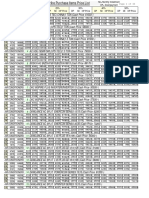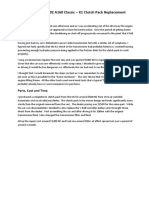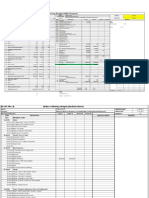0 ratings0% found this document useful (0 votes)
35 viewsProportioning Valve KIT Installation Instructions
Proportioning Valve KIT Installation Instructions
Uploaded by
Henry CanalesThis document provides instructions for installing a proportioning valve kit for vehicle brakes. The kit includes a proportioning valve, pre-bent lines, brake light wiring harness, mounting bracket, hardware, and cutaway diagram. It describes plugging the lines into the proportioning valve according to the diagram and warns that brakes must be properly tested before driving. It outlines a test procedure to check that the proportioning valve is operating correctly using a test light and bleeding both front and rear brakes simultaneously.
Copyright:
© All Rights Reserved
Available Formats
Download as PDF, TXT or read online from Scribd
Proportioning Valve KIT Installation Instructions
Proportioning Valve KIT Installation Instructions
Uploaded by
Henry Canales0 ratings0% found this document useful (0 votes)
35 views1 pageThis document provides instructions for installing a proportioning valve kit for vehicle brakes. The kit includes a proportioning valve, pre-bent lines, brake light wiring harness, mounting bracket, hardware, and cutaway diagram. It describes plugging the lines into the proportioning valve according to the diagram and warns that brakes must be properly tested before driving. It outlines a test procedure to check that the proportioning valve is operating correctly using a test light and bleeding both front and rear brakes simultaneously.
Original Description:
Bombas cpp
Original Title
555-631302_631303
Copyright
© © All Rights Reserved
Available Formats
PDF, TXT or read online from Scribd
Share this document
Did you find this document useful?
Is this content inappropriate?
This document provides instructions for installing a proportioning valve kit for vehicle brakes. The kit includes a proportioning valve, pre-bent lines, brake light wiring harness, mounting bracket, hardware, and cutaway diagram. It describes plugging the lines into the proportioning valve according to the diagram and warns that brakes must be properly tested before driving. It outlines a test procedure to check that the proportioning valve is operating correctly using a test light and bleeding both front and rear brakes simultaneously.
Copyright:
© All Rights Reserved
Available Formats
Download as PDF, TXT or read online from Scribd
Download as pdf or txt
0 ratings0% found this document useful (0 votes)
35 views1 pageProportioning Valve KIT Installation Instructions
Proportioning Valve KIT Installation Instructions
Uploaded by
Henry CanalesThis document provides instructions for installing a proportioning valve kit for vehicle brakes. The kit includes a proportioning valve, pre-bent lines, brake light wiring harness, mounting bracket, hardware, and cutaway diagram. It describes plugging the lines into the proportioning valve according to the diagram and warns that brakes must be properly tested before driving. It outlines a test procedure to check that the proportioning valve is operating correctly using a test light and bleeding both front and rear brakes simultaneously.
Copyright:
© All Rights Reserved
Available Formats
Download as PDF, TXT or read online from Scribd
Download as pdf or txt
You are on page 1of 1
631302 / 631303 Proportioning
Valve KIT Installation Instructions
(left Side Kit used for example, but instructions apply to all kits)
Included in this Kit:
1
2
Proportioning Valve
Pre-bent lines
Warning Proper operation
of your brakes is
essential for your safety and the safety
1 Brake light wiring harness of others. Any brake service should
1 Mounting bracket be performed ONLY by persons
2 5/16-18 bolts experienced in the installation and
2 washers-flat proper operation of brake systems.
2 washers-split locking It is the responsibility of the person
installing any brake component or
kit to determine the suitability of the
1/2"-20 7/16"-24 component or kit for the particular
3/8"-24
application. DO NOT DRIVE WITH
UNTESTED BRAKES!
9/16"-18 Install lines as shown in diagram:
The most common proportioning valve
plumbing is shown. An alternative plumbing
method is to plug off the top front line and
have the bottom front line go to a “T” fitting.
From the “T” fitting, the front lines are then
3/8"-24 631302 cutaway Shown split off to the left and right calipers.
Note: AFTER INSTALLATION REFER TO MASTER CYLINDER MANUFACTURER INSTRUCTIONS FOR PROPER BLEEDING
TESTING THE PROPORTIONING VALVE for proper operation:
1. Use a test light by attaching a clip to a positive contact on the vehicle and touch the point of the tester to the electrical
connection of the combination valve. If the light does not come on, the valve system is operating correctly and no
further testing is required.
2. If the light does come on, this indicates that the pressure differential valve is stuck in the front or rear position.
3. Bleed the brake system to determine if the front or rear lines are blocked off. Set up one front wheel and one rear
wheel for bleeding at the same time. Crack both bleeder screws and gently pump the pedal a few times. The blocked
side will trickle fluid out when the bleeder screw is cracked and the pedal pressed. An unblocked line will squirt fluid
out the bleeder.
4. The lines that are clear must be left open and the blocked lines should have the bleeder screws tight to cause pressure
to build up on that side. Be sure to use the standard bleeding procedures to prevent air from entering the system.
5. Slowly press the pedal with steady pressure a number of times until the light goes out; this will center the differential
valve. You may also hear a pop come from the proportioning valve. This is the metering valve returning to its
equalized position. When the light goes out, close the bleeder screw.
1-800-345-4545 Jegs Performance Products www.jegs.com
You might also like
- Bolens Lawn Tractor RepairDocument46 pagesBolens Lawn Tractor Repairdakehi1188342157% (7)
- Weldtron, Inc.: Instructions For The Installation of The Weldtron-57 R-57 Idler Control Upgrade KitDocument12 pagesWeldtron, Inc.: Instructions For The Installation of The Weldtron-57 R-57 Idler Control Upgrade KitMark trahanNo ratings yet
- 9829 3500 23 XRHS 930e - XRHS 1150e - XRVS 960 e - Asl Book - 2013-09-16Document102 pages9829 3500 23 XRHS 930e - XRHS 1150e - XRVS 960 e - Asl Book - 2013-09-16yangNo ratings yet
- ZF TraducirDocument25 pagesZF TraducirJose Rafael Ramos Chiquillo0% (1)
- 4-4 Demarcation of Scope For Bas SystemDocument2 pages4-4 Demarcation of Scope For Bas SystemAaron MokNo ratings yet
- Proportioning Valve KIT Installation InstructionsDocument2 pagesProportioning Valve KIT Installation InstructionsHenry CanalesNo ratings yet
- Proximity Switch InstallationDocument3 pagesProximity Switch InstallationSaleh AlomariNo ratings yet
- Freno Auxiliar Electrico HurstDocument7 pagesFreno Auxiliar Electrico HurstSam MarmorNo ratings yet
- Bell & Gossett: Circuit Setter Balance Valves 4" Thru 12" SizesDocument4 pagesBell & Gossett: Circuit Setter Balance Valves 4" Thru 12" SizessamNo ratings yet
- Circuit SetterDocument4 pagesCircuit SetterHVACRNIC2005No ratings yet
- Operating and Maintenance Instructions: Keystone Figure 79 Pneumatic ActuatorDocument13 pagesOperating and Maintenance Instructions: Keystone Figure 79 Pneumatic ActuatorjorgeNo ratings yet
- Alternator Install - AutoDocument4 pagesAlternator Install - AutoSharon ScottNo ratings yet
- Detroit Diesel Series 60 P-63 / P61: Problem Detection Repair InstructionsDocument2 pagesDetroit Diesel Series 60 P-63 / P61: Problem Detection Repair InstructionsMuhammad rizkiNo ratings yet
- I & M Mark V-100 Series: NtroductionDocument16 pagesI & M Mark V-100 Series: Ntroductionwagner machado de moraesNo ratings yet
- 24SI Installation Instructions 10513391Document2 pages24SI Installation Instructions 10513391Duy KhaNo ratings yet
- Circuit Setter Plus Model MC: Instruction ManualDocument4 pagesCircuit Setter Plus Model MC: Instruction Manualmacanipharoldf6220No ratings yet
- Manual Guides Keystone Figure 79 Pneumatic Actuator Keystone en en 2718292Document13 pagesManual Guides Keystone Figure 79 Pneumatic Actuator Keystone en en 2718292vjNo ratings yet
- 900 040 01Document8 pages900 040 01Alessandra FloresfarNo ratings yet
- Installation and Maintenance Information: Turbine Powered StartersDocument12 pagesInstallation and Maintenance Information: Turbine Powered StartersAbdelkader AbdelkaderNo ratings yet
- Hurst Roll Control Installation Instructions # 5671518: 2010 and Up CAMARODocument8 pagesHurst Roll Control Installation Instructions # 5671518: 2010 and Up CAMAROpramodh kumarNo ratings yet
- Actros .Rve..Alternatorinstallation Instructions 18siDocument2 pagesActros .Rve..Alternatorinstallation Instructions 18siVasile SilvioNo ratings yet
- Braking System 3Document10 pagesBraking System 3chaubalrohitNo ratings yet
- Ds 715Document2 pagesDs 715marranNo ratings yet
- AC4 - AC5 Horizntal Series ManualDocument8 pagesAC4 - AC5 Horizntal Series ManualDaniel RibeiroNo ratings yet
- Standard Gate Valves ManualDocument8 pagesStandard Gate Valves ManualmechanikyNo ratings yet
- Console Remote Control Installation InstructionsDocument18 pagesConsole Remote Control Installation InstructionsJoswyn LopesNo ratings yet
- 79U, E Spring Return and Double Acting Pneumatic Quarter-Turn Actuators Operations (2000)Document12 pages79U, E Spring Return and Double Acting Pneumatic Quarter-Turn Actuators Operations (2000)COILED TUBINGNo ratings yet
- FlowserverDocument12 pagesFlowserverCesar Cedano VivarNo ratings yet
- Fitting Instructions For Remote Vacuum Servo Units Types 6 and 7Document6 pagesFitting Instructions For Remote Vacuum Servo Units Types 6 and 7kyaw thatNo ratings yet
- Trailer Surge BrakeDocument28 pagesTrailer Surge Brakeken.babineauNo ratings yet
- PF5700 00 1.8TS Master US Dec 06Document1,654 pagesPF5700 00 1.8TS Master US Dec 06mohammedNo ratings yet
- Altronic GSVDocument8 pagesAltronic GSVhamadaNo ratings yet
- Manual Varec Series 180 181 Double Port Regulator Varec en en 5197388Document4 pagesManual Varec Series 180 181 Double Port Regulator Varec en en 5197388reneNo ratings yet
- Aventics R432015593 DatasheetDocument10 pagesAventics R432015593 Datasheetantony.ideharaNo ratings yet
- Instruction Manual BR33 enDocument20 pagesInstruction Manual BR33 enHimozaesNo ratings yet
- ASC Air Starter ST700 SeriesDocument29 pagesASC Air Starter ST700 SeriesLeonid KolesnikovNo ratings yet
- Operating Manual: Altronic Gas Control Valve, 690210Document12 pagesOperating Manual: Altronic Gas Control Valve, 690210Esau Jose PabloNo ratings yet
- Electric Actuator InstructionDocument40 pagesElectric Actuator Instructiongasm220% (1)
- Circuit Setter ManualDocument4 pagesCircuit Setter ManualAnonymous 7xHNgoKE6eNo ratings yet
- Dyn1 10654Document5 pagesDyn1 10654arturobatallasNo ratings yet
- FlowCon EVC Instruction 05.2010Document4 pagesFlowCon EVC Instruction 05.2010Jeff Anderson CollinsNo ratings yet
- ELS EtDocument12 pagesELS EtmanhngoducNo ratings yet
- Circuit Center ValvulaDocument4 pagesCircuit Center ValvulaLuis Carlos PardoNo ratings yet
- I & M 6800HP Series: Ideal Installation SchematicDocument4 pagesI & M 6800HP Series: Ideal Installation SchematicMultilibros VillamontesNo ratings yet
- Installation Instructions: CautionDocument4 pagesInstallation Instructions: CautionVMNo ratings yet
- Submersible Sewage Ejector Pump: Pump Installation and Service ManualDocument8 pagesSubmersible Sewage Ejector Pump: Pump Installation and Service Manualallen_worstNo ratings yet
- Installation Manual: LCS Series Integrated Speed Control and Direct Drive ActuatorDocument16 pagesInstallation Manual: LCS Series Integrated Speed Control and Direct Drive ActuatorSergio Ricardo IbañezNo ratings yet
- !!!WARNING!!!: 2R-Series 2R2500 & 2R3500 Double Acting & Spring Return Scotch Yoke ActuatorsDocument7 pages!!!WARNING!!!: 2R-Series 2R2500 & 2R3500 Double Acting & Spring Return Scotch Yoke ActuatorsAmaury FreireNo ratings yet
- 521 InstallDocument2 pages521 InstallmejmakNo ratings yet
- Chrysler Dakota Part16Document10 pagesChrysler Dakota Part16Sašo Brunšek-BrunoNo ratings yet
- Nordic 5900Document4 pagesNordic 5900adalberto vegaNo ratings yet
- Butterfly Valve SVADocument16 pagesButterfly Valve SVATelly DuquesneNo ratings yet
- Installation, Operation, Service & Repair Parts ManualDocument8 pagesInstallation, Operation, Service & Repair Parts Manualibula emmanuelNo ratings yet
- 98 Dodge Ram Truck SM SCSDocument1 page98 Dodge Ram Truck SM SCSEduardo MacMasterNo ratings yet
- K550 K550-38 New LabelDocument14 pagesK550 K550-38 New LabelJannie CoetzeeNo ratings yet
- Coleman Generator L0807053Document12 pagesColeman Generator L0807053Jody WoodenNo ratings yet
- P Roto Air ValveDocument11 pagesP Roto Air ValveKo LinNo ratings yet
- SSC81U Series Electronic Valve Installation Instru - enDocument5 pagesSSC81U Series Electronic Valve Installation Instru - endiego pereiraNo ratings yet
- SKI Elec Tronic Reverse (Line-Up) - Supplement mmr2017-121 enDocument9 pagesSKI Elec Tronic Reverse (Line-Up) - Supplement mmr2017-121 enErne Lange OlsenNo ratings yet
- 07-01 TroubleshootingDocument33 pages07-01 TroubleshootingVinod GuptaNo ratings yet
- The Book of the Singer Junior - Written by an Owner-Driver for Owners and Prospective Owners of the Car - Including the 1931 SupplementFrom EverandThe Book of the Singer Junior - Written by an Owner-Driver for Owners and Prospective Owners of the Car - Including the 1931 SupplementNo ratings yet
- Delco Radio Owner's Manual Model 633; Delcotron Generator InstallationFrom EverandDelco Radio Owner's Manual Model 633; Delcotron Generator InstallationNo ratings yet
- Delco Manuals: Radio Model 633, Delcotron Generator Delco Radio Owner's Manual Model 633, Delcotron Generator InstallationFrom EverandDelco Manuals: Radio Model 633, Delcotron Generator Delco Radio Owner's Manual Model 633, Delcotron Generator InstallationNo ratings yet
- p3449 PDFDocument6 pagesp3449 PDFHenry CanalesNo ratings yet
- sl35 Installation InstructionsDocument2 pagessl35 Installation InstructionsHenry CanalesNo ratings yet
- Prop Valve Mod InstructionsDocument1 pageProp Valve Mod InstructionsHenry CanalesNo ratings yet
- ReveDocument20 pagesReveHenry CanalesNo ratings yet
- ASME B18.12 (1962) - Glossary of Terms For Mechanical FastenersDocument77 pagesASME B18.12 (1962) - Glossary of Terms For Mechanical Fastenersgusla7No ratings yet
- Oman Museum Across AgesDocument15 pagesOman Museum Across AgesrakeshamechNo ratings yet
- Greenfield Generator Power CalculatorDocument1 pageGreenfield Generator Power CalculatorHarold PicoNo ratings yet
- Parts List 33 261 16 95: Helical-Bevel Gear Unit K97Document3 pagesParts List 33 261 16 95: Helical-Bevel Gear Unit K97Edmundo JavierNo ratings yet
- NLM BGB 2020 Book 2 en PDFDocument1,063 pagesNLM BGB 2020 Book 2 en PDFAntonio GuerreroNo ratings yet
- Measurement of Insulation Resistance of A CableDocument1 pageMeasurement of Insulation Resistance of A Cablealvin me0% (1)
- 3230F350 PARTS CatalogDocument5 pages3230F350 PARTS CatalogLIONN TESTE2021No ratings yet
- Ica Tae EvoDocument2 pagesIca Tae EvoIra BilokonNo ratings yet
- 2nd Gun For Glory Shooting ChampionshipDocument176 pages2nd Gun For Glory Shooting ChampionshipGunFor GloryNo ratings yet
- Electrolux PLD4375RFC3 Dishwasher InstallationDocument2 pagesElectrolux PLD4375RFC3 Dishwasher InstallationTom KakanowskiNo ratings yet
- HP CurrentPriceListZero NormalDocument46 pagesHP CurrentPriceListZero NormalMuneeba AttiqueNo ratings yet
- DMA FINISHED PLAN - Dma11062 - 20130621 PDFDocument137 pagesDMA FINISHED PLAN - Dma11062 - 20130621 PDFWee WeeNo ratings yet
- Mercedes A160 Classic K1 Clutch ReplacementDocument21 pagesMercedes A160 Classic K1 Clutch ReplacementPeter DezmanNo ratings yet
- 2-10 Calvin Hsieh - ディスプレイを基盤としたユーザーインターフェース:タッチ、指Document26 pages2-10 Calvin Hsieh - ディスプレイを基盤としたユーザーインターフェース:タッチ、指葉羽修No ratings yet
- CoaxialCable LMR100 LMR600Document4 pagesCoaxialCable LMR100 LMR600Anonymous XS9jAhY1pENo ratings yet
- Drawing Lecture 1Document28 pagesDrawing Lecture 1Real NazihNo ratings yet
- Working Budget SampleDocument8 pagesWorking Budget SampleCuong Pham KhacNo ratings yet
- How To Install A Home Security SystemDocument4 pagesHow To Install A Home Security SystemluvavaleNo ratings yet
- 6 Speed Transmission Gears & Related PartsDocument5 pages6 Speed Transmission Gears & Related PartsMarcela Liliana Molnar100% (1)
- 0-51A Oil Pump and Oil StrainerDocument2 pages0-51A Oil Pump and Oil StrainerBurik8No ratings yet
- Harken 40.2st 06Document2 pagesHarken 40.2st 06Stuartp1No ratings yet
- TN60 - E - 取説 manualDocument32 pagesTN60 - E - 取説 manualcavblackfhotmail.comNo ratings yet
- Samsung La32e420e2r PDFDocument2 pagesSamsung La32e420e2r PDFeric hipol100% (1)
- patent-US2937479-Crankshaft Journal GrinderDocument4 pagespatent-US2937479-Crankshaft Journal GrinderMahnooshNo ratings yet
- PS120Document4 pagesPS120ErickNo ratings yet
- 2016 Osprey Skate CatalogueDocument84 pages2016 Osprey Skate CatalogueDarkangelcaliNo ratings yet
- A6V10066619Document8 pagesA6V10066619Bruno PereiraNo ratings yet





























































































